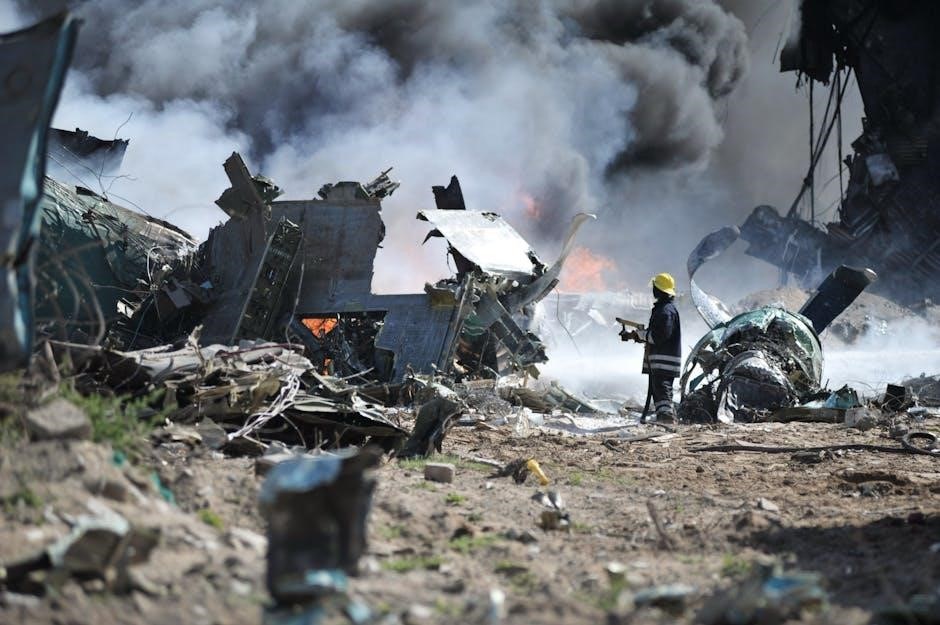Fire protection is crucial for safeguarding hazardous materials․ The Fire Protection Guide provides essential standards and practices for handling, storing, and responding to hazardous material incidents․ NFPA standards ensure safety and compliance․
1․1 Importance of Fire Safety in Handling Hazardous Materials
Fire safety is paramount when handling hazardous materials due to their potential to ignite, explode, or release toxic fumes․ Proper fire safety measures prevent catastrophic incidents, protecting people, facilities, and the environment․ Hazardous materials pose unique risks, requiring specialized fire protection strategies․ Adherence to standards like those from the National Fire Protection Association (NFPA) ensures safe handling and storage․ Fire safety protocols minimize risks of accidental ignition and mitigate consequences of fires․ Effective fire safety plans include detection systems, suppression methods, and emergency response strategies․ Training personnel and maintaining compliant facilities are critical to preventing and managing hazardous material fires, ensuring overall safety and regulatory compliance․
1․2 Overview of the Fire Protection Guide to Hazardous Materials
The Fire Protection Guide to Hazardous Materials is a comprehensive resource developed by the National Fire Protection Association (NFPA)․ It provides detailed information on identifying, handling, and mitigating fire risks associated with hazardous substances․ The guide includes critical data on flammability, toxicity, and environmental impact, along with best practices for storage, emergency response, and regulatory compliance․ It serves as a reference for fire safety professionals, emergency responders, and facility managers․ By adhering to the guidelines outlined in the document, individuals can ensure safer environments and effective incident management․ The guide is regularly updated to reflect the latest research and industry standards, making it an essential tool for anyone involved in hazardous material safety․

Basics of Fire Protection Systems
Fire protection systems combine detection, suppression, and alarm technologies to prevent fires and minimize damage․ These systems are tailored to address risks in hazardous material environments effectively․
2․1 Principles of Fire Protection
The principles of fire protection are centered around prevention, detection, and suppression․ Prevention involves eliminating ignition sources and controlling flammable materials․ Detection uses smoke and heat sensors to identify fires early․ Suppression systems, including sprinklers and clean agents, extinguish fires before they spread․ These principles are critical in environments handling hazardous materials, where uncontrolled fires can lead to catastrophic consequences․ Proper application of these principles ensures safety, reduces property damage, and protects the environment․ Compliance with NFPA standards and regular system maintenance are essential for effective fire protection․
2․2 Fire Suppression Systems for Hazardous Materials
Fire suppression systems for hazardous materials are designed to control and extinguish fires in environments where flammable or toxic substances are present․ These systems often utilize clean agents, carbon dioxide, or foam to minimize damage and prevent chemical reactions․ The selection of suppression agents depends on the type of hazardous material, its flammability, and the potential risks of chemical exposure․ Advanced systems may incorporate automated detection and activation to ensure rapid response․ Compliance with NFPA standards and regular maintenance are critical to ensure system reliability․ These systems are essential in industrial facilities, laboratories, and storage areas where hazardous materials are handled, providing a layered defense against fire-related hazards․
2․3 Fire Detection and Alarm Systems
Fire detection and alarm systems are vital components in fire protection, especially in hazardous material environments․ These systems use smoke detectors, heat sensors, and gas detectors to quickly identify fire risks․ Once a hazard is detected, alarms alert personnel, enabling prompt evacuation and response․ Advanced systems integrate with suppression systems for a coordinated response; NFPA guidelines ensure these systems are reliable and effective, minimizing risks in hazardous settings․ Regular maintenance and testing are essential to ensure functionality․ Early detection is critical to prevent small incidents from escalating, protecting lives and property effectively․ These systems are indispensable in maintaining safety in facilities handling hazardous materials․

Understanding Hazardous Materials
Hazardous materials pose significant risks due to their flammability, toxicity, and reactivity․ Proper classification and identification are essential for safe handling and storage․ NFPA guidelines provide critical information on managing these risks effectively, ensuring safety in various environments․
3․1 Classification of Hazardous Materials
The classification of hazardous materials is essential for safety and regulatory compliance․ The National Fire Protection Association (NFPA) provides a standardized system, such as the NFPA 704 standard, which uses a diamond-shaped label to communicate hazards․ This label categorizes materials based on flammability, health risks, and instability․ Each section of the diamond is assigned a rating from 0 to 4, indicating the severity of the hazard․ For example, flammable liquids are rated based on their flash point, while toxic substances are rated according to their health risks․ This system helps emergency responders and handlers understand the risks associated with each material․ Proper classification ensures safe handling, storage, and emergency response, minimizing potential dangers to people and the environment․
3․2 Identification of Hazardous Materials
Identification of hazardous materials is critical for ensuring safety and compliance with regulations․ The NFPA 704 standard provides a widely recognized system using a diamond-shaped label to communicate hazard information․ This label includes four colored sections: red for flammability, blue for health risks, yellow for instability, and white for special hazards․ Each section is assigned a rating from 0 to 4, with 4 indicating the highest hazard․ Additionally, DOT regulations require specific labeling for transportation, while OSHA mandates the use of SDS (Safety Data Sheets) to provide detailed information about each material․ Proper identification ensures that handlers, responders, and regulators can quickly understand the risks and take appropriate actions, reducing the likelihood of accidents and exposure to harmful substances․ This systematic approach is vital for maintaining a safe working environment and protecting public health․
3․3 Examples of Common Hazardous Materials
Common hazardous materials include flammable liquids like gasoline and acetone, toxic chemicals such as chlorine and ammonia, and corrosive substances like sulfuric acid․ Additionally, materials like propane, butane, and hydrogen fall under highly flammable gases․ Other examples include reactive substances like sodium and potassium, which can ignite spontaneously in certain conditions․ Hazardous materials also encompass carcinogens, such as benzene, and radioactive substances, which pose unique risks․ Proper identification and handling of these materials are essential to prevent accidents and ensure safe storage and transportation․ These examples highlight the diversity of hazardous materials and the need for stringent safety protocols to mitigate risks․
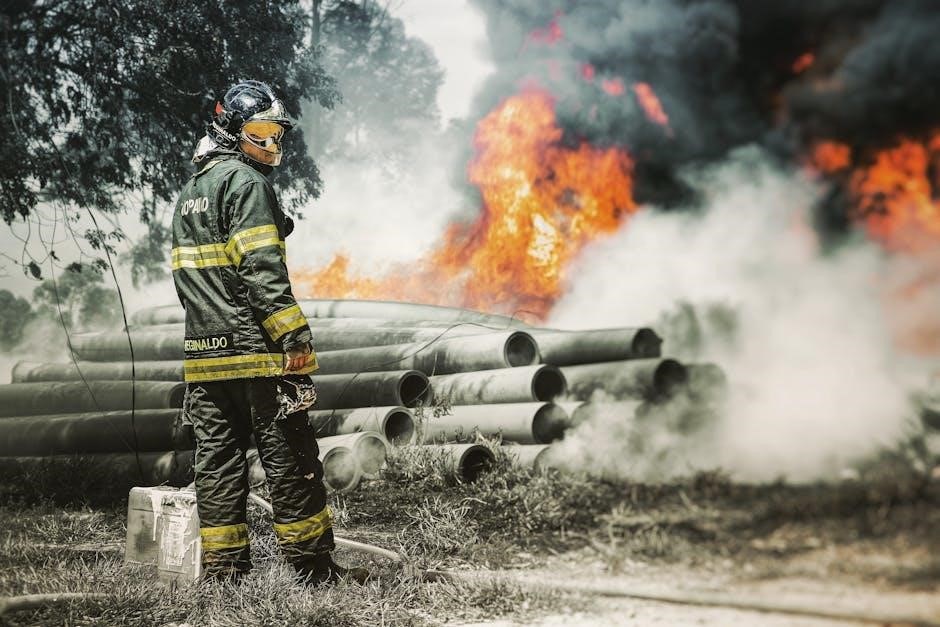
Fire Hazards and Risks Associated with Hazardous Materials
Hazardous materials pose significant fire risks due to their flammability, toxicity, and potential environmental impact․ Proper mitigation strategies are essential to prevent catastrophic incidents and ensure safety․
4․1 Flammability and Combustibility of Hazardous Materials
Flammability refers to how easily a material ignites, while combustibility indicates its ability to sustain a fire․ Hazardous materials vary widely in these properties, with some requiring minimal energy to ignite․ NFPA ratings and the Fire Protection Guide provide detailed assessments of these risks․ Proper storage and handling are critical to prevent ignition sources from triggering fires․ Inadequate ventilation can exacerbate combustibility, leading to rapid fire spread․ Understanding these properties is vital for designing effective fire protection systems and ensuring safe environments for handling hazardous substances․ Regular training and adherence to safety protocols are essential to mitigate these risks effectively․
4․2 Toxicity and Health Risks from Hazardous Materials
Hazardous materials pose significant toxicity risks, threatening human health and safety․ The Fire Protection Guide emphasizes the importance of understanding these risks to prevent exposure․ NFPA standards and regulations outline safe handling practices to minimize toxic exposure․ Inhalation, skin contact, or ingestion of hazardous substances can lead to severe health issues, including respiratory distress, organ damage, or even death․ Emergency responders must use personal protective equipment (PPE) to mitigate these risks․ Proper ventilation, storage, and spill containment are critical to reducing toxicity hazards․ OSHA regulations mandate training and equipment to safeguard workers․ Understanding toxicity risks ensures effective emergency preparedness and protects both people and the environment from harmful exposures․
4․3 Environmental Impact of Hazardous Material Fires
Hazardous material fires pose significant risks to the environment․ The release of toxic fumes, particulate matter, and hazardous byproducts can contaminate air, water, and soil․ These fires often result in long-term ecological damage, affecting wildlife and ecosystems․ Contaminated water sources can harm aquatic life and potentially affect human health․ Soil pollution from hazardous residues can disrupt plant growth and soil quality․ The Environmental Protection Agency (EPA) emphasizes the importance of containment and cleanup to minimize environmental harm․ Preventive measures, such as proper storage and fire suppression systems, are critical to reducing the risk of hazardous material fires and their devastating environmental consequences․ Protecting the environment requires a proactive approach to fire safety and hazardous material management․

Regulations and Standards for Fire Protection
Regulations like NFPA standards, OSHA guidelines, and EPA requirements ensure safe handling and storage of hazardous materials, minimizing fire risks and environmental hazards․ Compliance is essential․
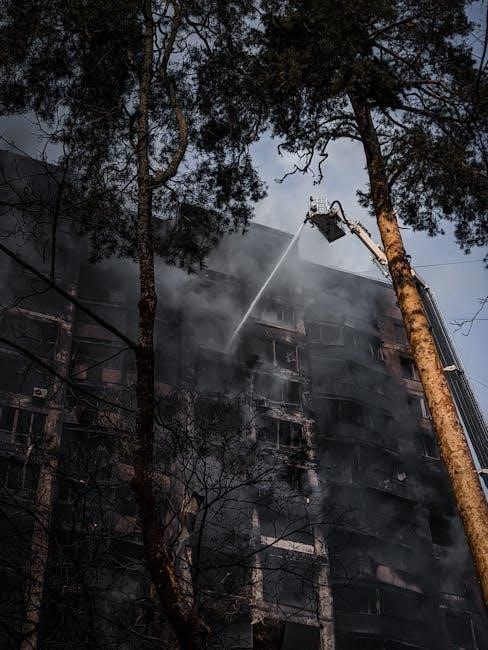
5․1 NFPA Standards for Hazardous Materials
The National Fire Protection Association (NFPA) provides comprehensive standards for managing hazardous materials․ NFPA 325 and NFPA 491 outline fire hazard properties and safe handling practices, ensuring protection for people and the environment․ These standards include guidelines for storage, transportation, and emergency response, while also addressing fire suppression systems and personal protective equipment․ Compliance with NFPA standards is critical for preventing fires and mitigating risks associated with hazardous materials․ By adhering to these regulations, industries can maintain safety and reduce potential liabilities․ The NFPA continuously updates its standards to reflect advancements in technology and best practices in fire protection․
5․2 OSHA Regulations for Hazardous Material Handling
The Occupational Safety and Health Administration (OSHA) regulates hazardous material handling to ensure workplace safety․ Key standards include 29 CFR 1910․120 for hazardous waste operations and 29 CFR 1910․138 for hand protection․ Employers must provide training on handling, storage, and emergency response․ OSHA mandates the use of personal protective equipment (PPE) like gloves, goggles, and respirators to minimize exposure risks․ Hazard communication programs are required to inform workers about chemical dangers․ Facilities handling hazardous materials must also maintain emergency response plans and proper spill control measures․ Compliance with OSHA regulations is essential to prevent accidents and protect both workers and the environment from potential hazards․ These standards ensure a safer working environment for all individuals involved in hazardous material operations․
5․3 EPA Guidelines for Hazardous Material Storage
The U․S․ Environmental Protection Agency (EPA) provides guidelines for storing hazardous materials to prevent environmental contamination․ These guidelines emphasize proper container labeling, leak prevention, and spill containment․ Facilities must ensure storage areas are well-ventilated and protected from ignition sources․ The EPA also mandates regular inspections of storage containers and secondary containment systems․ Hazardous waste must be stored in accordance with the Resource Conservation and Recovery Act (RCRA) regulations․ Additionally, the EPA requires emergency response plans for potential spills or leaks to minimize environmental impact․ Compliance with these guidelines ensures the safe management of hazardous materials, protecting both human health and the environment from potential hazards․ Proper storage practices are critical to preventing accidents and maintaining regulatory compliance․

Fire Risk Assessment for Hazardous Materials
Fire risk assessment identifies potential ignition sources and evaluates the severity of risks posed by hazardous materials․ It ensures proper safety measures are in place to minimize hazards and protect assets․
6․1 Conducting a Fire Risk Assessment
Conducting a fire risk assessment involves identifying hazards, evaluating risks, and implementing controls․ NFPA guidelines recommend assessing ignition sources, flammable materials, and potential fire spread paths․ This process ensures compliance with safety standards and reduces risks․
6․2 Identifying Potential Fire Hazards
Identifying potential fire hazards involves analyzing materials, processes, and environmental factors․ Hazardous materials, such as flammable liquids and gases, pose significant risks․ Electrical equipment and hot surfaces can act as ignition sources․ NFPA guidelines emphasize classifying materials based on their fire properties, such as combustibility and flash points․ For example, materials classified under NFPA 704 as highly flammable or reactive require special handling․ Environmental factors, like dust accumulation or chemical vapors, also contribute to fire risks․ Regular inspections and hazard mapping help pinpoint these risks, ensuring proactive measures to prevent fires and protect people and facilities from potential hazards․ Understanding these factors is critical for effective fire safety planning and risk mitigation strategies․
6․3 Mitigating Fire Risks in Hazardous Material Storage
Mitigating fire risks in hazardous material storage requires a multi-faceted approach․ Proper storage facilities must be designed with fire-resistant materials and equipped with fire suppression systems․ NFPA standards recommend separating incompatible materials to prevent accidental ignition․ Ventilation systems are crucial to reduce the buildup of flammable vapors․ Regular training for staff on handling and emergency procedures is essential․ Fire detection systems, such as smoke detectors and gas sensors, should be installed to provide early warnings․ Additionally, ensuring compliance with OSHA and EPA regulations helps maintain a safe environment․ Routine inspections and maintenance of storage areas further minimize risks, ensuring the protection of both personnel and the environment from potential fire hazards․

Storage and Handling Practices for Hazardous Materials
Secure storage facilities must be well-ventilated and equipped with fire suppression systems․ Materials should be properly labeled and segregated based on compatibility․ Staff training and emergency plans are essential․
7․1 Safe Storage of Hazardous Materials
Safe storage of hazardous materials requires adherence to NFPA standards, ensuring proper containment and segregation․ Storage areas must be well-ventilated, fire-resistant, and equipped with suppression systems․ Materials should be stored in approved containers, clearly labeled, and organized by compatibility to prevent accidental reactions․ Access should be restricted to trained personnel only․ Regular inspections are crucial to identify potential hazards and ensure compliance with safety protocols․ Proper signage and emergency response plans must be in place․ Additionally, storage facilities should comply with EPA guidelines to minimize environmental risks․ Using FM Approved products ensures reliability in fire protection systems․ Proper training of staff handling these materials is essential for maintaining a safe environment and preventing incidents․
7․2 Proper Handling Techniques for Hazardous Materials
Proper handling of hazardous materials is critical to prevent accidents and exposure․ Use of personal protective equipment (PPE) like gloves, goggles, and respirators is essential․ Ensure all materials are handled in well-ventilated areas, away from ignition sources․ Follow NFPA guidelines for lifting and transferring materials to avoid spills․ Use approved containers and ensure they are tightly sealed․ Labels must be clear and include hazard warnings․ Training on emergency procedures, such as spill containment and fire response, is mandatory․ Regular drills and inspections ensure readiness․ Always refer to the Safety Data Sheet (SDS) for specific handling instructions․ Proper techniques minimize risks to personnel and the environment, aligning with OSHA and EPA regulations․ Compliance with these standards ensures a safe working environment and effective hazard control․
7․3 Labeling and Signage Requirements
Proper labeling and signage are essential for identifying hazardous materials․ Containers must be labeled with the material’s name, hazard class, and warning information․ The National Fire Protection Association (NFPA) diamond-shaped label system is widely used to communicate hazards․ Labels should include flammability, health, and reactivity ratings․ Signage for storage areas must indicate the type of hazard and provide emergency contact information․ OSHA and EPA regulations require clear and visible warning signs to alert responders and employees․ Labels and signs must be in English and include pictograms for quick recognition․ Regular inspections ensure compliance, and updates are made as regulations change․ Proper labeling and signage are critical for preventing accidents and ensuring a rapid, informed response during emergencies․
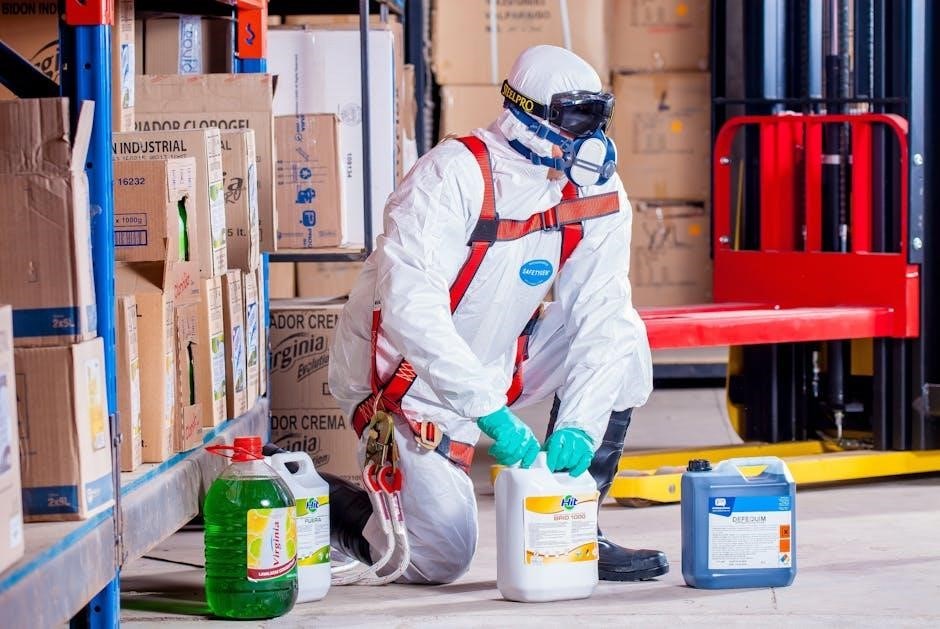
Emergency Preparedness and Response
Effective emergency preparedness involves developing response plans, training personnel, and equipping them with PPE․ Coordination with local authorities ensures a unified and efficient response to hazardous material incidents․
8․1 Developing an Emergency Response Plan
A comprehensive emergency response plan is critical for managing hazardous material incidents․ It should include risk assessments, roles, and procedures for containment, evacuation, and communication․ The plan must outline the use of personal protective equipment (PPE) and ensure regular training for responders․ Coordination with local authorities and emergency services is essential for a unified response․ Regular reviews and updates to the plan are necessary to adapt to new risks and regulatory changes․ A well-structured plan ensures timely and effective action, minimizing risks to people, the environment, and facilities during hazardous material emergencies․
8․2 Procedures for Fire Emergencies Involving Hazardous Materials
In the event of a fire involving hazardous materials, immediate action is critical to prevent escalation․ Evacuate the area, seal off access points, and notify emergency services․ Trained responders should wear appropriate personal protective equipment (PPE) to minimize exposure․ Assess the situation to identify the type of hazardous material involved and its potential risks․ Use fire suppression methods compatible with the material, such as dry chemical or foam, avoiding water for certain chemicals․ Containment measures, like creating barriers, can prevent further spread․ Coordinate with local fire departments and hazardous material teams for specialized assistance․ Post-incident, conduct a thorough cleanup and decontamination to ensure safety․ Adhering to NFPA guidelines ensures effective and safe management of such emergencies․
8․3 Personal Protective Equipment (PPE) for Emergency Responders
Personal Protective Equipment (PPE) is essential for emergency responders handling hazardous material fires․ This includes fire-resistant suits, gloves, goggles, and respirators to protect against toxic fumes and chemical exposure․ The selection of PPE depends on the material’s risks, as outlined in NFPA standards․ Full-face respirators with appropriate filters are critical for airborne hazards․ Thermal-protective gear prevents burns from heat and flames․ Properly fitted PPE ensures mobility and visibility during operations․ Training on PPE use is vital to avoid malfunctions․ Improper use can lead to exposure, making PPE a lifeline for responders․ Always follow NFPA guidelines to ensure safety and effectiveness in hazardous situations․
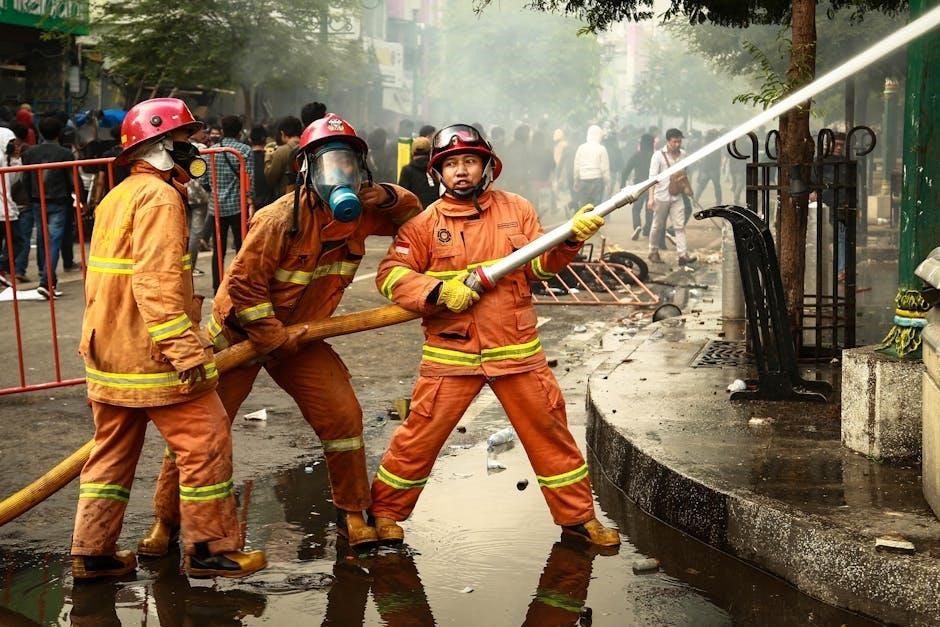
Case Studies and Lessons Learned
Real-world incidents involving hazardous materials highlight critical safety lessons; Past fires reveal gaps in protocols, inspiring improved practices and stronger regulations to prevent future disasters․
9․1 Notable Fires Involving Hazardous Materials
Several high-profile fires involving hazardous materials have underscored the importance of robust safety measures․ For instance, the 2024 Downingtown Fire Department incident highlighted the risks of uncontrolled chemical releases․ Another notable case was a chemical plant fire in 2021, which released toxic fumes, emphasizing the need for advanced containment strategies․ These events often result from lapses in storage or handling protocols, leading to severe environmental and health impacts․ Such incidents have prompted stricter regulations and improved emergency response plans․ By analyzing these fires, experts can identify vulnerabilities and develop better practices to mitigate future risks․ These case studies serve as critical learning tools for enhancing fire protection and hazardous material management․
9․2 Lessons Learned from Hazardous Material Fires
Analysis of past fires involving hazardous materials reveals critical lessons for improving safety․ A key takeaway is the importance of adhering to strict storage and handling protocols to prevent accidental ignition․ Emergency preparedness plans must be regularly updated and tested to ensure effective response․ Proper use of personal protective equipment (PPE) by responders is essential to minimize exposure to toxic substances․ Additionally, clear communication and coordination between emergency services and facility operators are vital to contain incidents swiftly․ These lessons emphasize the need for proactive measures, such as regular inspections and employee training, to reduce risks․ Implementing these insights can significantly enhance safety and mitigate potential disasters involving hazardous materials․
9․3 Best Practices Derived from Real-World Incidents
Real-world incidents highlight best practices for managing hazardous materials․ Proactive risk assessments and regular training are essential to prepare for emergencies․ Implementing state-of-the-art detection systems ensures early warning of potential hazards․ Proper labeling and signage of stored materials aid in quick identification during emergencies․ Collaboration with local authorities and adherence to NFPA and OSHA guidelines are crucial․ Regular equipment maintenance and emergency drills enhance preparedness․ These practices, learned from past incidents, are vital to safeguarding lives and preventing environmental damage․ By integrating these strategies, facilities can create a safer environment for handling hazardous materials effectively․
The Fire Protection Guide to Hazardous Materials serves as a comprehensive resource for ensuring safety and compliance․ By adhering to NFPA standards and understanding the risks associated with hazardous materials, industries can minimize fire hazards and protect both people and the environment․ Proper storage, handling, and emergency preparedness are critical to preventing incidents․ The guide emphasizes the importance of regular training, advanced detection systems, and adherence to regulatory requirements․ Real-world incidents underscore the need for proactive measures and continuous improvement in safety practices․ Ultimately, this guide provides the tools necessary to create a safer and more resilient environment for managing hazardous materials effectively․
